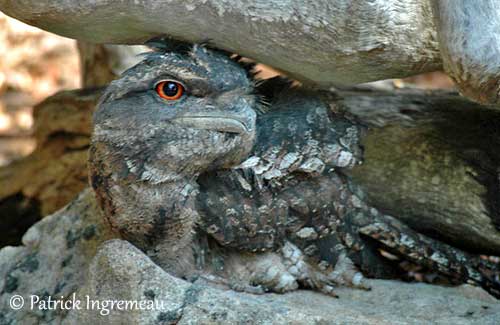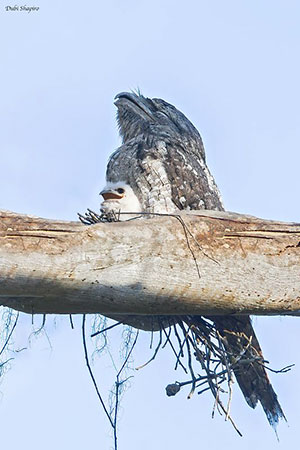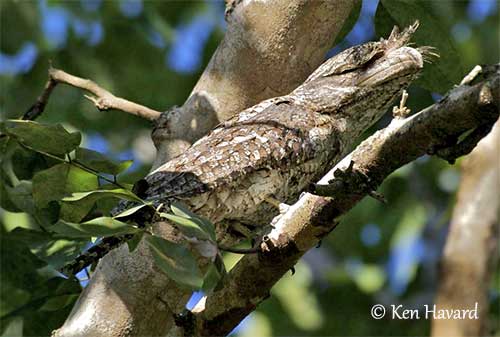
PROTECTION / THREATS / STATUS:
The Papuan Frogmouth is described as common in Australia, and usually not uncommon and even fairly common in New Guinea.
This species is able to adapt to modified habitats such as clearing and development of agriculture.
The size of the population is unknown, but it is suspected to be stable.
The Papuan Frogmouth is not globally threatened, and currently evaluated as Least Concern.
Fr: Podarge papou
Ang: Papuan Frogmouth
All: Papuaschwalm
Esp: Podargo Papú
Ita: Bocca di rana papua
Nd: Reuzenuilnachtzwaluw
Sd: papuagrodmun
Photographers:
Ken Havard
My Bird Gallery & Flickr gallery 1 & Flickr gallery 2
Patrick Ingremeau
TAMANDUA
Otto Plantema
Trips around the world
Dubi Shapiro
Dubi Shapiro Photo Galleries
Text by Nicole Bouglouan
Sources:
HANDBOOK OF THE BIRDS OF THE WORLD Vol 5 by Josep del Hoyo-Andrew Elliott-Jordi Sargatal - Lynx Edicions - ISBN: 8487334253
L’ENCYCLOPEDIE MONDIALE DES OISEAUX - Dr Christopher M. Perrins - BORDAS - ISBN: 2040185607
Cairns Zoom - Papuan Frogmouth: Fact File
ACADEMIA - A prolonged agonistic interaction between two Papuan Frogmouths Podargus papuensis
Wikipedia, the free encyclopaedia
Papuan Frogmouth
Podargus papuensis
Podargiformes Order – Podargidae Family
INTRODUCTION:
The family Podargidae includes only two genera, with Podargus from Australasia, and Batrachostamus from Asia, the birds of the latter being smaller in size.
The Papuan Frogmouth is the largest of all Podargidae. It occurs in the W Papuan Islands (New Guinea) and in N and E Queensland (Australia). This species is nocturnal and feeds primarily on insects caught in the large, frog-like beak, but it also takes mice, frogs and small reptiles. It frequents moist, lowland forests from sea-level to 1,000 metres of elevation. It is monogamous with long-term pair bonds. The nest is a flimsy platform made with twigs and placed on horizontal tree fork. Both adults share the nesting duties.
The Papuan Frogmouth is not globally threatened, and the population is suspected to be stable.
DESCRIPTION OF THE BIRD:
Biometrics:
Length: 45-60 cm
Weight: M: 414 g – F: 314 g
The Papuan Frogmouth may have variable plumage coloration with mottled brown, grey and pale buff patterned feathers, making the bird very well camouflaged against tree trunks. The wings may appear darker.
The underparts are usually paler, mainly pale grey-brown with white spots and irregular bars, and some blackish streaks.
The tail is fairly long and the wings are rounded.

The broad, frog-like bill is bulbous with wide gape. It is usually pale grey with narrow nostrils near the base, protected by a membrane. We can see several stiff feathers and bristles. The eyes are bright red, or orange, yellow or brown, depending on the light. The very short legs and the feet are rather weak. They are pale greyish to pale brownish.
The female resembles male, but the upperparts are usually browner or more rufous, and her plumage pattern is duller, less contrasting. She is smaller than male.
The female also occurs in rufous morph, with almost plain cinnamon plumage. But this morph is very rare.
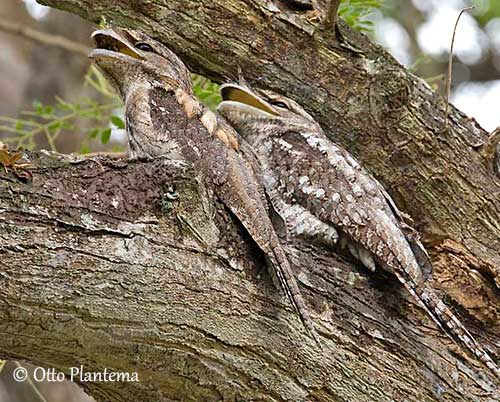
The juvenile has very variable coloration, usually like adults but also much paler, and the underparts are mainly white.
RANGE:
The Papuan Frogmouth is found in New Guinea in W Papuan Islands, including those of Geelvink Bay, Aru Islands, and NE Australia in N and E Queensland (Cape York Peninsula S to Staaten R and Paluma Range).
HABITAT:
The Papuan Frogmouth frequents moist, lowland forest, rainforest edges, gallery forest along streams, swamp-woodland and mangroves in Australia.
In New Guinea, it can be seen in wooded savannas, second growth and gallery forest, scrub and urban gardens.
This species is visible from sea-level to 1,000 metres of elevation, rarely higher.
CALLS AND SONGS: SOUNDS BY XENO-CANTO
The Papuan Frogmouth gives a strange, repetitive, very low-pitched sound, a resonant “ooom ooom ooom ooom ooom…” and this song is believed to be that of the female, but both mates sing. This song is given during the breeding season. However, several other calls are used in territory defence and often end in a loud, sharp, mechanical bill-snap “Wu-Wu-wu-wu-u CLAK!”
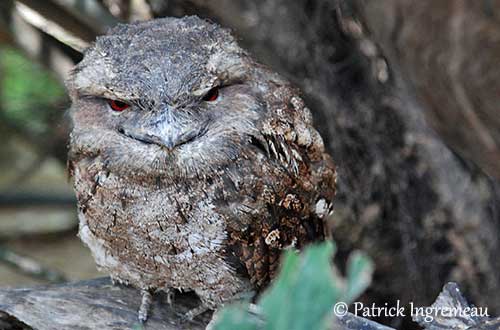
BEHAVIOUR IN THE WILD:
The Papuan Frogmouth feeds primarily on insects such as grasshoppers and large beetles and other insect species. But it also takes spiders, mice, frogs, small reptiles and occasionally small birds.
It has impressive hunting techniques. It usually hunts from exposed perch and performs sallies, gliding silently and slowly to catch the prey.
This bird has a frog-like beak which is bright yellow inside. When hunting, it opens the mouth to reflect the moonlight and insects are attracted by the yellow colour. The large, hard prey are brought to the perch where they are crushed before to be swallowed. This species has nocturnal habits.
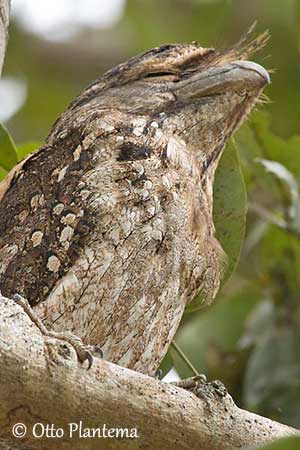
The Papuan Frogmouth is monogamous with long-term pair bonds, and usually both mates stay together for life. This species builds a flimsy platform on horizontal tree fork. Both adults share the nesting duties.
They become aggressive when defending their young. They may gape, hiss and snap the bill, or flutter at the intruder while snapping the bill.
The Papuan Frogmouth is sedentary and remains in the same territory all year round.
The frogmouths fly strongly but they do not disperse or migrate. They are very agile while hunting, swooping down from a perch in silent, slow flight.
REPRODUCTION OF THIS SPECIES:
The breeding season occurs between August and December in Australia, with peak in October/November. In New Guinea, the laying may occur in dry season, between (at least) July and November.
The Papuan Frogmouth builds a flimsy nest with a few sparse twigs forming a rough platform. It is placed on horizontal tree fork, between 6 and 20 metres above the ground.
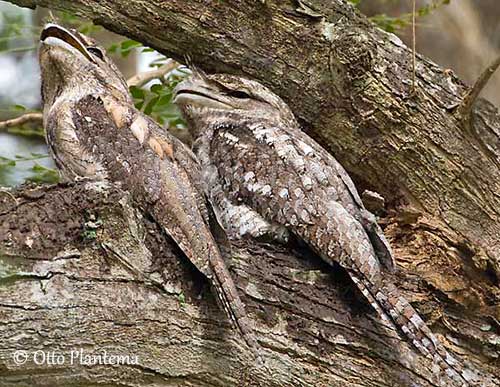
The female lays one or two white eggs, usually only one. The incubation is shared by both adults. The male incubates during the day while the female remains at nest by night. During the incubation, the bird remains motionless and always faces in the same direction. This behaviour can help protect the egg from falling to the ground through the flimsy structure. During the night, the incubating bird is fed on the nest by its partner. The duration of the incubating period is unknown.
